BRP – Elan Valley Aqueduct – Birmingham Resilience Project (2020)
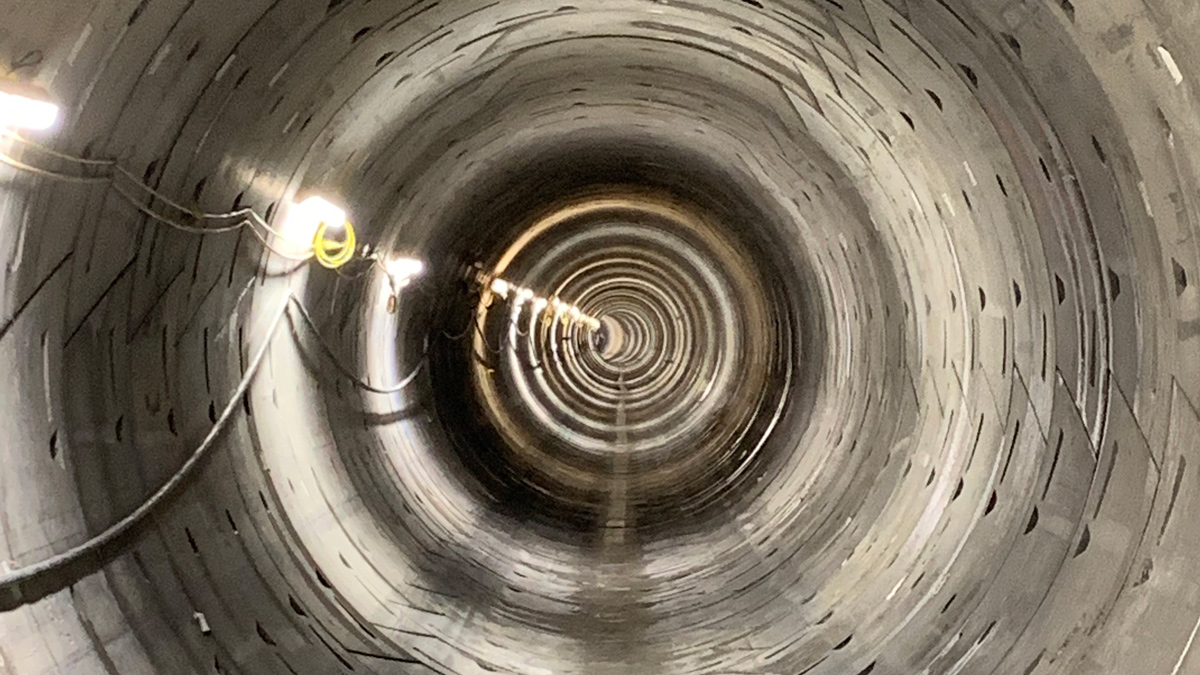
A view from inside the new Frydd Wood bypass tunnel - Courtesy of Severn Trent
Between 1893 and 1904 the Birmingham Corporation dammed the Elan Valley in Wales and constructed an aqueduct to channel water to Birmingham. At the height of the industrial revolution, between 1800 and 1900 Birmingham was booming, and its population rose substantially. Following outbreaks of smallpox and diarrhea, city officials deemed it essential to provide its residents and industries with safe drinking water, and James Mansergh an eminent engineer (and later President of the Institution of Civil Engineers) was brought in to determine a source of supply. Mansergh identified the Elan Valley in Wales, but transporting water such a distance inland required an innovative solution; the Elan Valley Aqueduct, which to this day still supplies water to Birmingham entirely by gravity.
Background to the works
Having supplied water for over 100 years, the aqueduct was beginning to tire in three key locations and Severn Trent identified the need to protect the structure. Severn Trent explored the possibility of internal repairs but the time available between aqueduct draining and restoring supply made this unfeasible. Having ruled out internal repairs, Severn Trent identified that the best option would be to replace three sections off-line and use the planned shutdowns to drain the aqueduct and connect into the existing pipeline. BNMA – a Barhale/North Midland Construction (now Galliford Try) Alliance – was appointed to deliver these new sections in Bleddfa, Nantmel, and Frydd Wood.
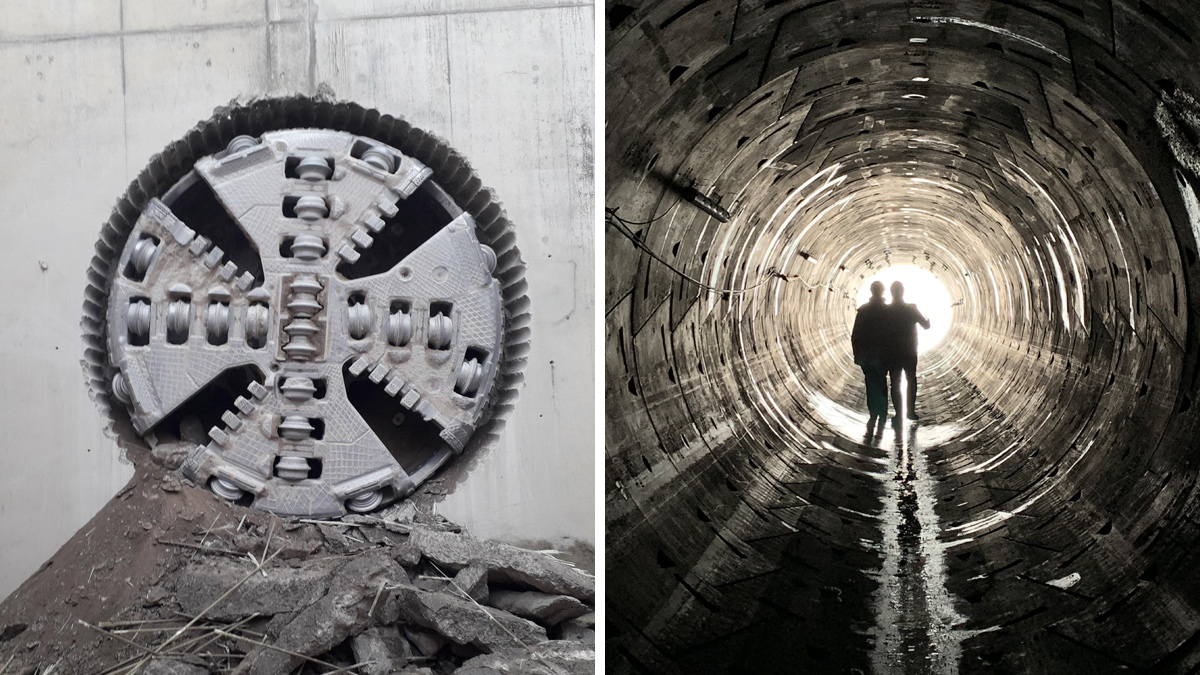
(left) ‘Offa’, the aptly named TBM following its successful breakthrough into the downstream wellhouse structure above Knighton, and (right), inside the new Frydd Wood tunnel – Courtesy of Severn Trent
Design and construction
The new aqueduct bypass sections are all 3.05m diameter, segmentally lined circular tunnels, constructed using an earth pressure balance tunnel boring machine (TBM).
- Bleddfa: In 2017, the Bleddfa bypass was successfully completed replacing a 1.8km section of the ageing aqueduct. In delivering this section, the team pioneered innovative techniques that generated significant efficiencies for the project and protected supply for Severn Trent’s customers. These techniques were adopted on the subsequent sections at Nantmel and Frydd Wood. The Bleddfa section was featured in detail in UK Water Projects 2017.
- Nantmel: The new 1km tunnel at Nantmel has been in operation since 2018, and the existing section, including a masonry crossing, has been decommissioned. The Nantmel section was featured in detail in UK Water Projects 2018 along with an introduction to the Frydd Wood section.
- Frydd Wood: The section in the town of Knighton replaces the Frydd Wood conduit and is 1.8km in length. The new tunnel runs under the Scheduled Ancient Monument of Offa’s Dyke. The environmental controls on site were of particular importance given the projects close proximity to a Site of Special Scientific Interest (SSSI). The Frydd Wood aqueduct bypass was successfully completed and commissioned in March 2020.
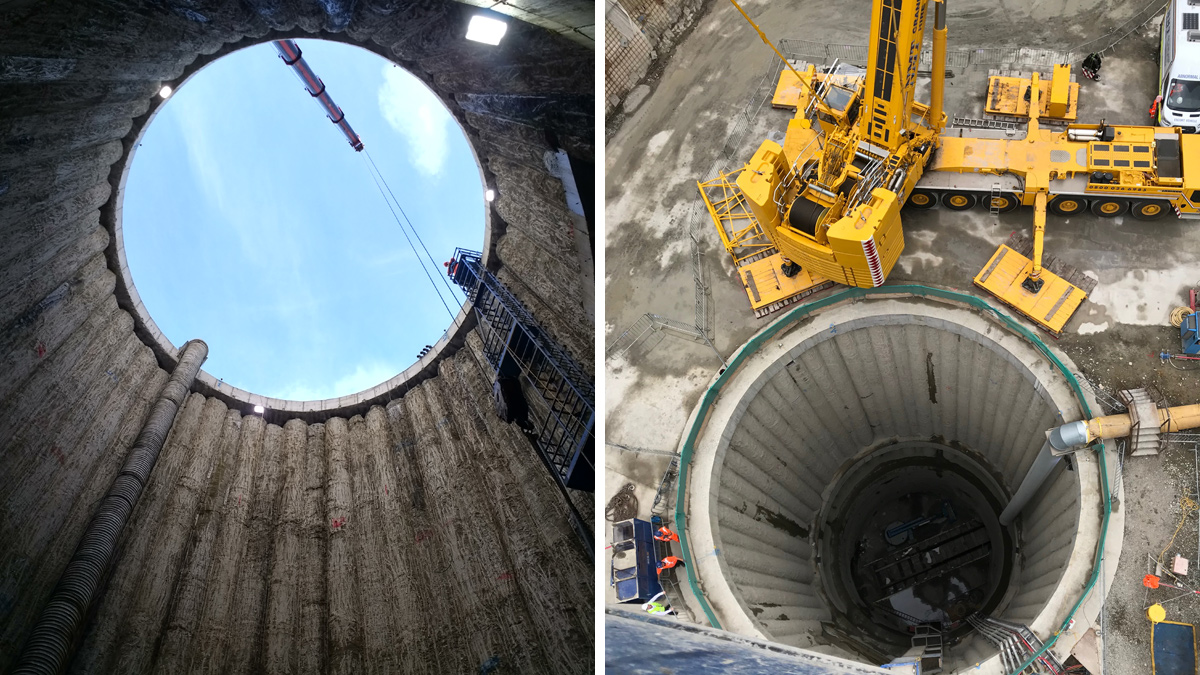
View from both inside and above the Frydd Wood upstream TBM drive shaft – Courtesy of Severn Trent
BRP Elan Valley Aqueduct: Supply chain
- Delivery contractor: BNMA – a Barhale/North Midland Construction (now Galliford Try) Alliance
- Civil Lead designer: GHD
- Civils designer: Nicholas O’Dwyer
- MEICA designer: EMR ltd
- Hydraulic modelling: Atkins
- Pipeline/civils: PLS
- Precast concrete structure: Carlow Concrete
- Secant piling: J Murphy
- Aarsleff soil nailing: Aarsleff Ground Engineering
- Reinstatement & earth moving: PJ Martin
- Aggregate recycling: HCD demolition
- Specialised pipe cutting: Mactech (Europe) Limited
- M&E panel build, PLC etc: CEMA
- M&E: IMAC
- Penstock design & manufacture: Auma
- Penstock design & manufacture: R2M Limited
- High level tunnel: Active Tunnelling
- Tunnel boring machine: Herrenknecht
Construction of the Frydd Wood site
The steep topography of the work areas at Frydd Wood meant that significant earthworks and temporary accesses had to be constructed to allow BNMA to complete the TBM drive. At the upstream TBM launch site, a large soil nail retaining wall was designed and constructed to support not only excavated batter but the A488 above the excavation area. This also allowed for both the transition shaft and the TBM drive shaft to be constructed on a flat platform.
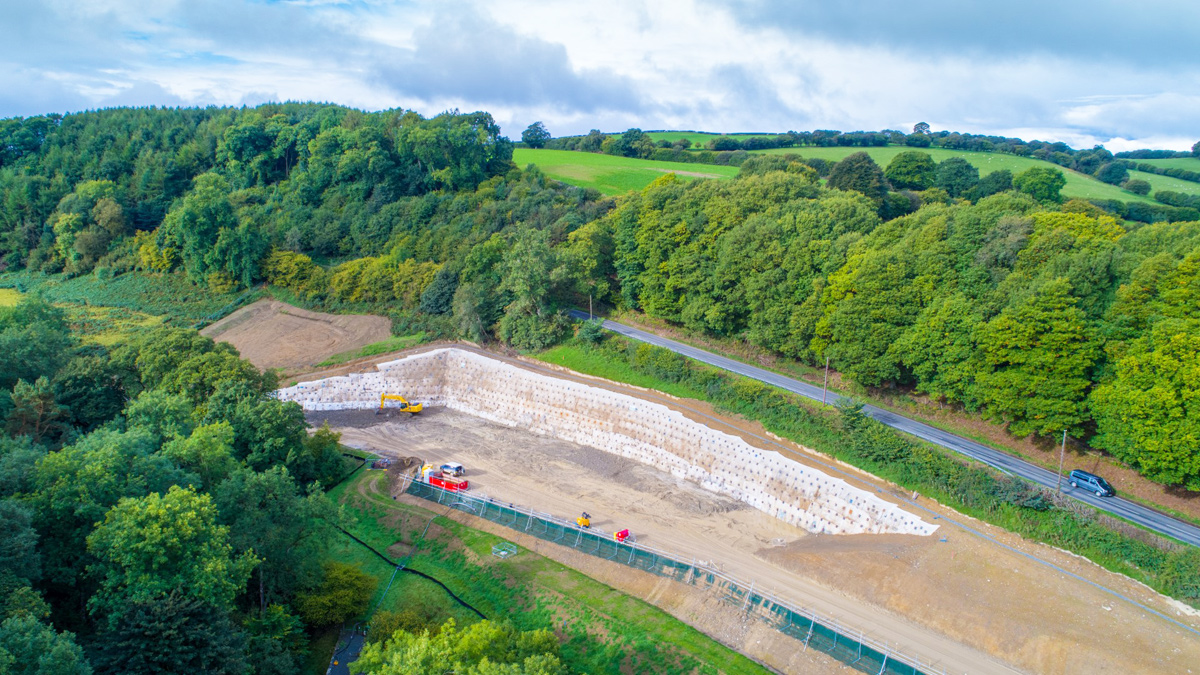
Frydd Wood upstream site access and soil nail wall – Courtesy of Severn Trent
Upstream transition shaft: Due to the depth of the TBM drive shaft (35m) a shallower transition shaft was constructed online of the existing aqueduct, which would form the upstream connection point. The transition shaft connected the existing aqueduct to the deeper drive shaft and the new tunnel. Within the transition shaft the aqueduct was exposed in discrete sections and wrapped in reinforced concrete to protect the 100 year old structure.
The new connection walls and precast concrete transition sections were then installed offline of the protected aqueduct. During a planned shutdown in March 2019 the remaining sidewall of the old aqueduct was removed to connect the old structure to the new channel. A twin wall reinforced stop log system was installed within the new flow channel to accommodate for live flow diversions at a later date.
Once the aqueduct had been drained, the first stage of the works involved demolishing this layer of protection. A large section was cut out of the structure to expose the existing aqueduct below. The team then set to work breaking out and demolishing the existing brickwork and concrete with machine mounted breakers.
Prior to the demolition operations the team constructed a new transition structure which tied into the concrete wrap. This concrete structure will channel flows from the upstream aqueduct into the newly constructed tunnel. Two sets of stop logs were installed at the end of the new transition structure to seal the structure from the tunnelling area.
Finally, precast concrete roof slab sections were lifted in place over the top of the structure to totally enclose the aqueduct before the flows were restored.
On completion of the tunnelling the transition was extended the full length of the pit to tie into the new tunnel system.
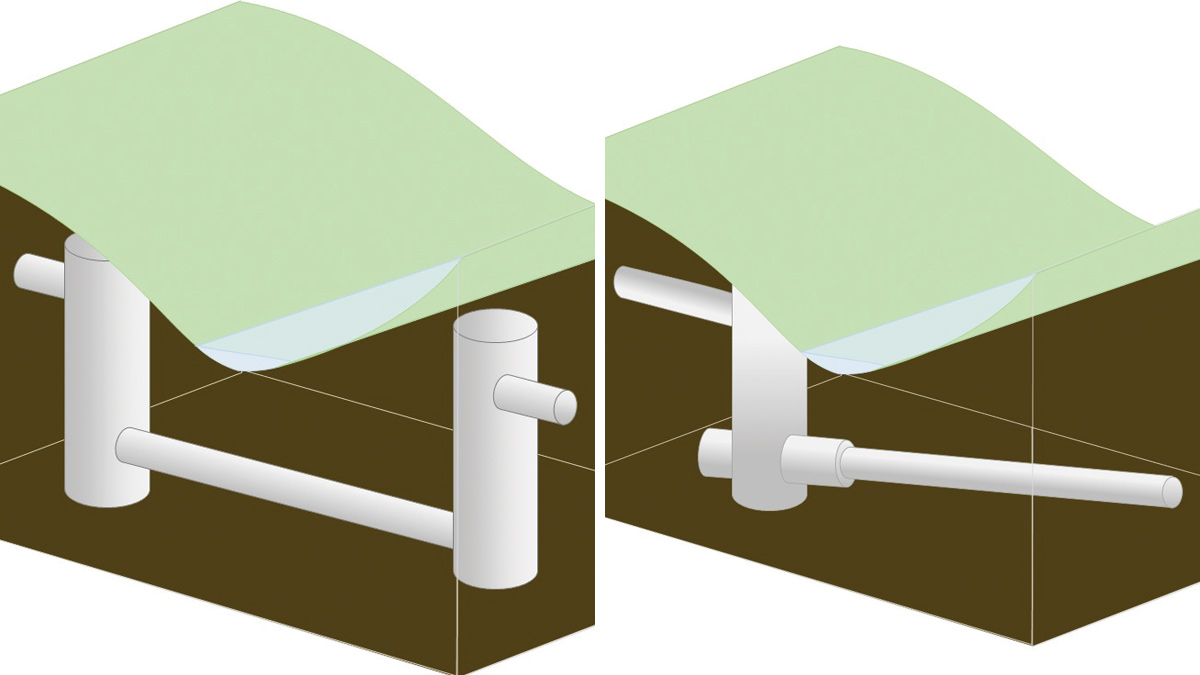
(left) The initial solution involved driving the TBM between two shafts under a stream and (right) GHD’s solution to eliminate one of the shafts – Courtesy of GHD
Upstream TBM drive shaft: Unlike the previous shallow, open cut TBM drive sites at Bleddfa and Nantmel, the Frydd Wood TBM was launched from a deep shaft to enable the tunnel to pass under a water course. BNMA’s design partners, GHD, designed a tunnel which gradually rose after passing beneath the stream. This allowed one continuous tunnel drive for the 1.8km and eliminated the time, cost and resources needed for a second-deep shaft, which was proposed in the initial design.
The new tunnel operates as syphon along this section of the aqueduct.
Downstream wellhouse construction: The new wellhouse structure was located adjacent to the original Victorian wellhouse on a steep hillside and close to private properties. To construct the wellhouse at the appropriate level and location significant rock had to be removed from the hillside. The new wellhouse was constructed in parallel to the upstream launch site in readiness to act as the reception chamber for the TBM, which broke through in Spring 2019, completing the 1.8km drive.
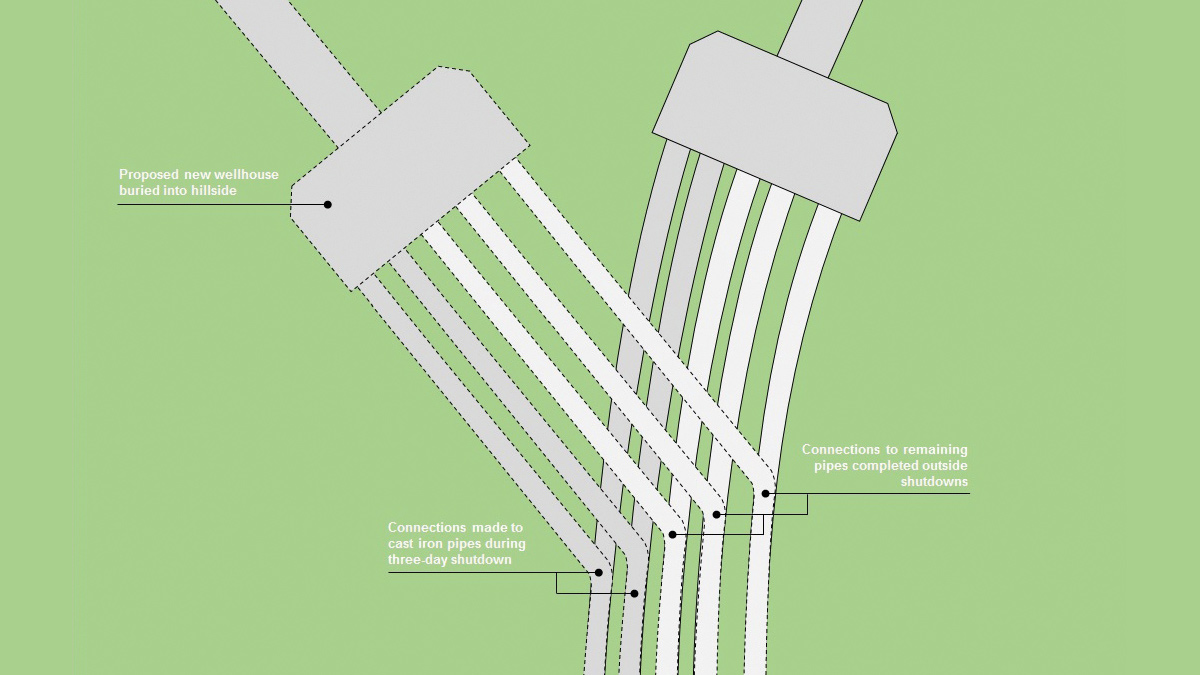
Plan view of the downstream connection to the existing syphon mains – Courtesy of Severn Trent
Wellhouse connections
The new wellhouse was connected onto the existing 5 siphon pipes, and not one singular conduit section, as was the case at Bleddfa and Nantmel. This presented numerous challenges to BNMA, especially given the short timescales allowed to complete the connections.
Special 60” and 42” elbow bends were manufactured to connect the existing larger diameter steel pipes and the smaller cast iron mains to the new wellhouse. Connections were made using a combination of both welded joints and large diameter flange adapters.
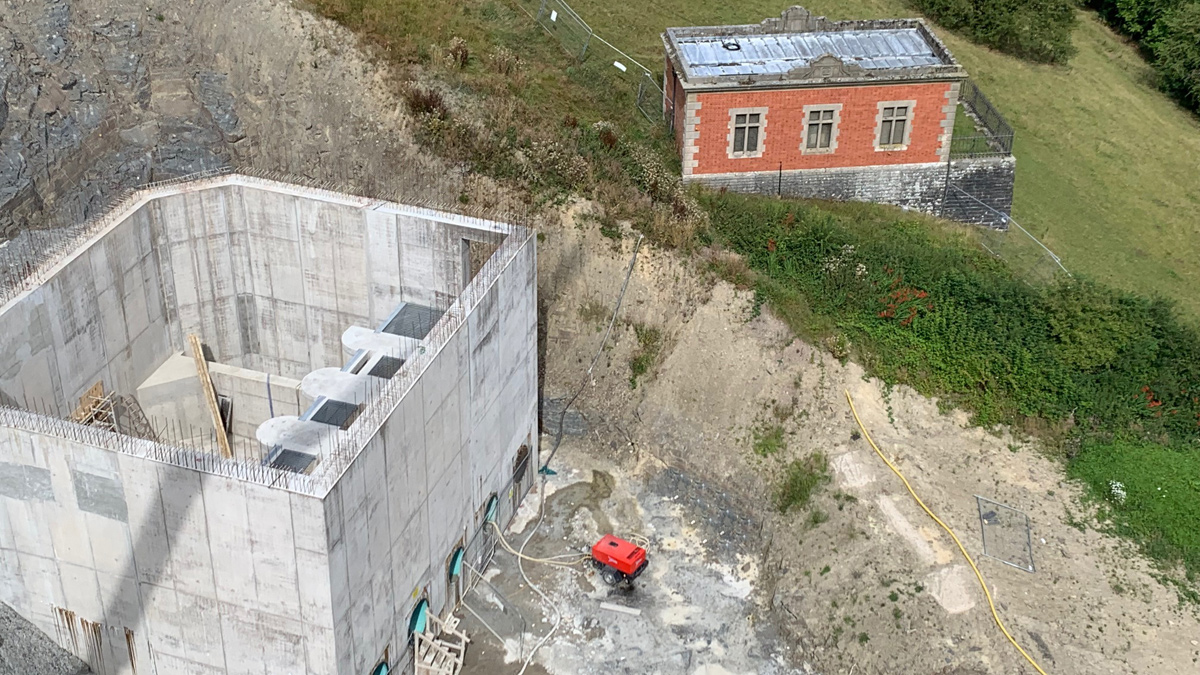
Aerial view of the new wellhouse adjacent to the original Victorian wellhouse structure – Courtesy of Severn Trent
Shutdown restriction: Like the Bleddfa and Nantmel projects the Frydd Wood connections had to be completed during short duration interventions. This required efficient design and extensive collaborative planning to avoid customer impact.
The connections were completed during two interventions in February and March 2020. During the first three-day intervention the two larger diameter 60” mains were isolated upstream to allow them to be connected and commissioned. This meant that for a short period of time the aqueduct operated as a dual system whereby the majority of the flow bifurcated in the transition shaft and ran through the new tunnel and wellhouse, with the remaining water flowing through the existing Victorian asset.
In March 2020 the final 3 steel 42” mains were connected and commissioned. Once all of the downstream connections were completed the precast concrete diversion blocks were placed and grouted in position in the upstream transition shaft to permanently divert all of the flow through the new bypass tunnel and wellhouse.
Innovative large diameter pipe cutting solution: In order to make the final syphon connections the existing pipes needed to be cleanly cut. Following various pipe cutting trials BNMA used an innovative and unique pipe cutting approach. A 60” diamond wire saw from Mactech (Europe) Limited was used. The tool, which is most-commonly used for subsea oil rig decommissioning, completed each cut within 1 hour.
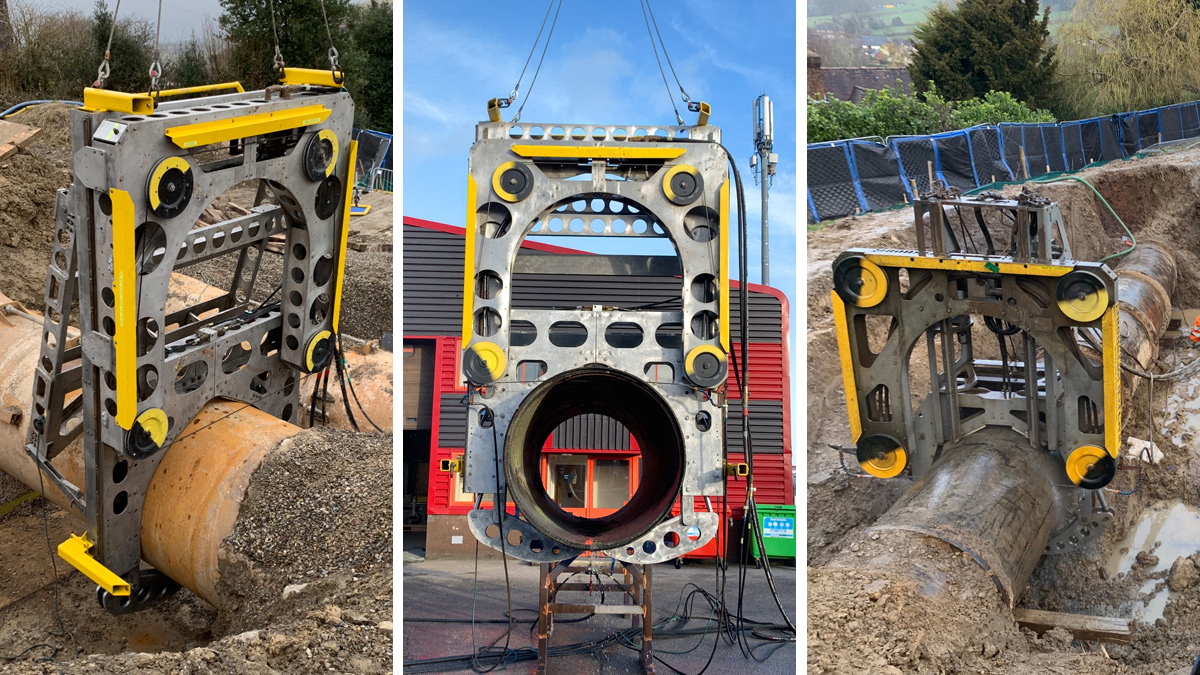
The innovative Mactech (Europe) Limited diamond wire cuts (left and right) on site, used to make the efficient pipe cuts (middle) being tested at their Aberdeen factory with a spare section of EVA 60” pipe and a smaller cutter being used on the smaller 42” diameter mains – Courtesy of Severn Trent
Summary
The team has helped secure significant time and cost savings through a range of innovative designs at each of the sites. On all three sites the project involved the staged excavation and exposure of the existing aqueduct structure, avoiding the need for internal propping and keeping it operational during excavation.
The method used across all three sites allows flows to be turned while the aqueduct was live. This has minimised the reliance on the shutdowns as the amount of work during these has been reduced which helped to protect programme and maintained a continuity of supply to Severn Trent’s customers.
As the EVA is now over 100 years old it requires regular maintenance to keep it in service for the future. The creation of the three bypass tunnels on the EVA are essential to Severn Trent’s water supply resilience to Birmingham.











